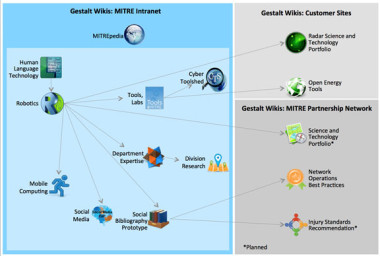Gestalt Wikis at MITRE: Origins

Wikis are an obvious first-line resource for knowledge sharing now. Wasn’t always the case, of course. Bernadette Clemente talks about how MITRE volunteers built our first enterprise wikis in 2005, with special pages for human language technology and robotics. The key to their success? Remembering to build user engagement. —Editor
Author: Bernadette Clemente
MITRE began using wikis on its intranet in 2005, when a group of volunteers created MITREpedia. Using open source MediaWiki[1] as its underlying wiki software, MITREpedia aimed to capture information about MITRE’s “people, projects, organizations, customers, technology and more.” [2] MITREpedia used categories to organize collections of related articles. Its navigation sidebar enabled users to visit recent changes and the last 10 pages viewed for each user.
Moving from Competency Area Status Reports to Focused-Topic Wikis
Shortly after MITREpedia came into existence, I was asked to report about the status of human language technology (HLT) competency area at MITRE. After interviewing HLT experts and collecting information about projects, customers, and technologies, I recommended that this information be organized into a living collection using wiki technology rather than a status report that would be quickly out-of-date. This is how focused-topic wikis came into existence. Languapedia made it easier to find HLT information. We structured pages using semantic annotations for experts, projects, organizations, customers, and technologies, using MediaWiki and a suite of wiki extensions based on Semantic MediaWiki,[3] which enabled querying and visualizing wiki data. Its navigation sidebar enabled users to visit views of HLT experts, projects, organizations, customers, and technologies. The resulting views, consisting of lists, tag clouds, geospatial maps, and timelines, made the concept of “contribute once, use many ways” very attractive to the HLT community and other knowledge communities… … and thus Robopedia made its debut in 2007.
The robotics team saw Languapedia and wanted a similar living collection for robotics, machine vision, and autonomy. Designed with a different structure, Robopedia used report forms to drive the automatic generation of pages about projects, contributors, organizations, technologies, and locations. These report forms enabled Robopedians to contribute information to a report page and then view aggregations of report information on user, location, project, and organization pages, too. Below is an automatically generated Robopedia user page showing aggregated report information as tag clouds. (See Figure 1)
Championed by a strong community leader, Robopedia became and continues to be the largest single-topic wiki at MITRE, with 8,829 pages and 40 authors who have contributed at least five articles. The success of Robopedia set off a series of initiatives that expanded our wiki building team from one to seven, and led to the development of more than 70 wikis on the MITRE intranet, the MITRE Partnership Network (on which we collaborate with customers and other stakeholders), and customer sites. We now refer to our work as Gestalt wikis. The term reflects the “contribute once, use many ways” concept that the whole was greater than the sum of its parts. Each new wiki was built on previous wiki structure and implementation. As we created the additional wikis, patterns of use emerged across the custom structures for projects, experts, and other types of pages. The newer wikis used up-to-date versions of MediaWiki and Semantic MediaWiki as well as MITRE-developed extensions. With each upgrade to the underlying wiki software, we expanded enterprise capabilities. We even retrofitted older wikis with our latest improvements. (See Figure 2)
Building engagement…
The hardest problem in knowledge management is engagement. Wikis allow communities to become stakeholders of their content and its structure. Dedicated knowledge communities have benefited from the opportunity to customize the structure for their knowledge—and tend to post more work of higher quality. We envision that we will be able to federate all our wikis in the future via convergence across different wiki structures as well as through innovative ways to connect the wikis seamlessly under a common interface. In the meantime, community engagement is our focus.
…while building more sophisticated platforms
Wikis are designed for distributed, multi-author knowledge building. Our customers need to collaborate across organizations to build knowledge and make decisions collectively just as much as we do. One wiki on the MPN, for example, enables an organization to harvest best practices for its network operations. Two additional wikis are planned to support mixed-partner co-authoring. Robopedia will transition to the MPN in the future as well. Engaging customers as co-authors of wiki content and structure early in the process increases MITRE’s responsiveness and strengthens our relationships with customers. Over the years, MITREpedia stewards periodically requested that Gestalt stewards transfer their content from their wiki to MITREpedia. However, Gestalt Wikis used wiki-specific structures to query and visualize content, extensions, and user interface style. MITREpedia was an unstructured wiki and had not moved toward the use of Wikipedia-style portal templates to organize collections of related articles. Gestalt Wikis were customer-funded projects and driven by customer needs. In comparison, MITREpedia was a largely unfunded, volunteer project.
…and building bridges In the summer of 2014, a way to bridge both approaches to enterprise wikis presented itself. Over time, MITREpedia stewards moved on to other jobs. As a result, MITREpedia was unable to keep its MediaWiki software up-to-date and eventually its server machine became unstable. The Gestalt team stepped in to help. We exported all of MITREpedia’s pages as XML with history and then imported them into a new virtual machine with an up-to-date operating system, LAMP[4] stack, MediaWiki software, and extensions from the Gestalt Wiki Framework.
References
[1] Mediawiki. (nd). http://mediawiki.org
[2] MITRE. (2005, 13 October). MITREpedia Main Page history.
[3] Semantic MediaWiki. (nd). https://semantic-mediawiki.org/
[4] LAMP means Linux, the Apache HTTP Server, the MySQL database, and the PHP programming language. For more information, see https://en.wikipedia.org/wiki/LAMP_(software_bundle)



0 Comments